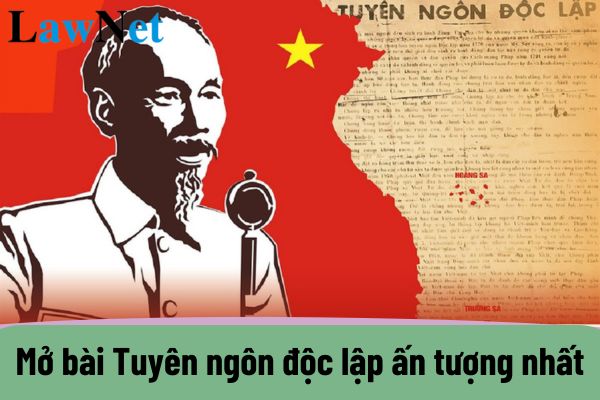What are the Top 5 most impressive introductions for essays on the work "Tuyên ngôn độc lập"? How many academic topics does the 12th-grade Literature curriculum in Vietnam include?
What are the Top 5 most impressive introductions for essays on the work "Tuyên ngôn độc lập"?
"Tuyên ngôn độc lập" was drafted and read by President Ho Chi Minh at the historic Ba Dinh Square on September 2, 1945. This declaration not only marked the birth of an independent nation but also stood out as an exceptional piece of political literature, deeply imprinted with the personal touch of President Ho Chi Minh.
The work "Tuyên ngôn độc lập" is studied in the 12th-grade Literature curriculum.
12th-grade students can refer to the following most impressive introductions for essays on the work "Tuyên ngôn độc lập":
|
Top 05 most impressive introductions for essays on the work "Tuyên ngôn độc lập"
Introduction 1:
"Tuyên ngôn độc lập" by Ho Chi Minh is a heroic anthem of great historical significance, marking the birth of an independent and free nation. Read on September 2, 1945, at Ba Dinh Square, Hanoi, the declaration was not only the official proclamation of the establishment of the Democratic Republic of Vietnam but also a powerful message about human rights to freedom and equality. Ho Chi Minh skillfully used humanitarian ideas to reject colonial subjugation and invasion, asserting the Vietnamese nation's right to self-determination. The declaration holds not only historical value but also profound lessons on freedom, independence, and fervent patriotism.
Introduction 2:
In the glorious pages of the nation's history, the "Tuyên ngôn độc lập" is an unforgettable milestone. Read by President Ho Chi Minh on September 2, 1945, this declaration was not only the official proclamation of the birth of an independent nation but also a powerful affirmation of the freedom and independence of the Vietnamese people. Ho Chi Minh employed sharp language, combined with scientific and humane reasoning, to refute all theories of invasion and colonialism, while also rallying the national spirit of unity. The "Tuyên ngôn độc lập" is a proclamation to the world about the right to self-determination and the Vietnamese nation's vigorous rise.
Introduction 3:
The "Tuyên ngôn độc lập" by Ho Chi Minh is an outstanding political work, with national and global stature. Read at Ba Dinh Square on September 2, 1945, this declaration not only affirmed the birth of the Democratic Republic of Vietnam but was also a triumphant song and a strong indictment against the brutal colonial policies of France and Japan. With a tone full of pride and decisiveness, Ho Chi Minh asserted the freedom and independence of the Vietnamese nation and emphasized justice, rejecting all invasive theories of external forces. The declaration is an invaluable historical document demonstrating the strength of the Vietnamese people in the struggle for independence.
Introduction 4:
"Tuyên ngôn độc lập" by Ho Chi Minh is the first declaration in the history of the Vietnamese nation, affirming the freedom, independence, and self-determination of the Vietnamese people. Read on September 2, 1945, this declaration was not only the recognition of a new nation but also an undeniable affirmation of the right to life, freedom, and sovereignty of all peoples worldwide. The "Tuyên ngôn độc lập" is a historical indictment of colonialism and imperialism and a call for the world to recognize the Vietnamese people's right to freedom.
Introduction 5:
"Tuyên ngôn độc lập" by Ho Chi Minh is an extremely meaningful and important work in the history of the Vietnamese nation. Read during the National Day celebration on September 2, 1945, this declaration not only proclaimed the birth of the Democratic Republic of Vietnam but also testified to the resilience and indomitable spirit of the Vietnamese people in their long struggle for the right to freedom and independence. Ho Chi Minh used sharp and simple reasoning to prove the right to self-determination of the Vietnamese nation, affirming that the Vietnamese people have completely cast off the shackles of slavery and are ready to rise to determine their own destiny.
|
*Note: The information is for reference only./.

What are the Top 5 most impressive introductions for essays on the work "Tuyên ngôn độc lập"? How many academic topics does the 12th-grade Literature curriculum in Vietnam include? (Image from the Internet)
How many academic topics does the 12th-grade Literature curriculum in Vietnam include?
Under Section IV of the General Education Program for Literature issued with Circular 32/2018/TT-BGDDT, there are 03 academic topics in the 12th-grade Literature curriculum in Vietnam as follows:
- Topic 12.1. PRACTICE RESEARCH AND WRITE A REPORT ON A MODERN AND POSTMODERN LITERATURE MATTER
- Topic 12.2. UNDERSTANDING AN ART PIECE ADAPTED FROM LITERATURE
- Topic 12.3. UNDERSTANDING THE CREATIVE STYLE OF A LITERARY SCHOOL: CLASSIC, REALISTIC, OR ROMANTIC
What are the required outcomes for the first academic topic in the 12th-grade Literature curriculum in Vietnam?
Under Section IV of the General Education Program for Literature issued with Circular 32/2018/TT-BGDDT, the required outcomes for the first academic topic in the 12th-grade Literature curriculum in Vietnam are:
Topic 12.1: PRACTICE RESEARCH AND WRITE A REPORT ON A MODERN AND POSTMODERN LITERATURE MATTER
- Know the requirements and methods for researching a matter.
- Know how to write a research report.
- Understand and apply some knowledge from the topic to read and write about modern and postmodern literature.
- Know how to present a researched modern and postmodern literature matter.


